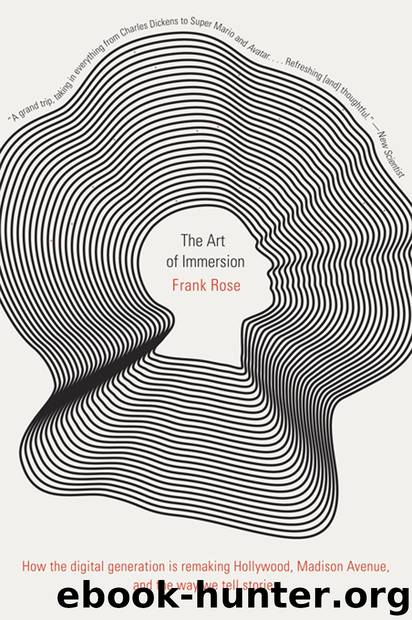The Art of Immersion by Frank Rose

Author:Frank Rose
Language: eng
Format: epub
Publisher: W. W. Norton & Company
Published: 2011-10-11T04:00:00+00:00
IF NBC WAS GOING TO GO 360, the obvious place to start was Heroes. The new series had Lost written all over it. It was created by Tim Kring, the writer-producer behind NBC’s Boston crime series Crossing Jordan—the show where Damon Lindelof had first been noticed. Jeph Loeb, a co–executive producer, had been a writer on the second season of Lost. Jesse Alexander, another co–executive producer, had worked with Lindelof and J. J. Abrams at the inception of Lost and with Abrams before that on Alias. Best of all was the concept: with the success of Lost, NBC was all too eager to have a serial drama with an ensemble cast and a story that would go over big at Comic-Con.
In the case of Heroes, that meant characters out of the comics: a high school cheerleader whose body spontaneously regenerates; a New York artist who can see into the future, but only after shooting up; a Tokyo office worker who can travel through time; an online stripper with dual personalities, one of which has superhuman strength; an LA policeman who can read minds; a politician who can fly; a male nurse with the power to mimic other people’s powers; a serial killer who steals other people’s brains so he can make their powers his own. There’s also a conspiracy involved, and all kinds of fancy genetics, and a threat to destroy New York City.
The pilot was screened at Comic-Con in July 2006, the same week that Lindelof and Cuse were accused during the Lost panel of orchestrating a Hanso Foundation cover-up, and it went over big. When it aired on television that fall, the series premiere drew 14 million viewers—nearly 5 million fewer than Lost’s opening episode that season, but still more than any new drama NBC had premiered in the previous five years.
Jesse Alexander took charge of the 360 aspect of the show—everything beyond the TV screen. It was a good fit. Like Abrams and Lindelof, Alexander was a child of Star Wars. He was 10 years old when it came out. He had bought all the comics and all the action figures, and soon he was using his Darth Vader and Luke Skywalker figures to make little Star Wars films with the Super 8 camera his dad had bought him. He understood fan participation and deep media storytelling instinctively, because that’s how he had grown up.
At Alias, he had taken a cue from Neil Young’s Majestic and Jordan Weisman’s alternate reality game for AI. A character would mention a Web site on the show, and when fans went there they would discover not only the site Alexander had built but audio files he had hidden there. He’d gone online in character as a spy and handed off information to another spy while fans watched. Heroes was a chance to do this in a way that was much more integrated into the story. Alexander and his team did online comics that appeared after every episode and were later published as graphic novels.
Download
This site does not store any files on its server. We only index and link to content provided by other sites. Please contact the content providers to delete copyright contents if any and email us, we'll remove relevant links or contents immediately.
Influence: The Psychology of Persuasion by Robert B. Cialdini(4715)
The Miracle Morning by Hal Elrod(4636)
The Hacking of the American Mind by Robert H. Lustig(4318)
Pre-Suasion: A Revolutionary Way to Influence and Persuade by Robert Cialdini(4142)
Unlabel: Selling You Without Selling Out by Marc Ecko(3587)
Ogilvy on Advertising by David Ogilvy(3503)
Hidden Persuasion: 33 psychological influence techniques in advertising by Marc Andrews & Matthijs van Leeuwen & Rick van Baaren(3472)
Purple Cow by Seth Godin(3137)
Who Can You Trust? by Rachel Botsman(3086)
Kick Ass in College: Highest Rated "How to Study in College" Book | 77 Ninja Study Skills Tips and Career Strategies | Motivational for College Students: A Guerrilla Guide to College Success by Fox Gunnar(3070)
The Marketing Plan Handbook: Develop Big-Picture Marketing Plans for Pennies on the Dollar by Robert W. Bly(2975)
This Is Marketing by Seth Godin(2969)
I Live in the Future & Here's How It Works by Nick Bilton(2933)
The Power of Broke by Daymond John(2895)
Building a StoryBrand by Donald Miller(2838)
The Tipping Point by Malcolm Gladwell(2822)
The 46 Rules of Genius: An Innovator's Guide to Creativity (Voices That Matter) by Marty Neumeier(2796)
Draw to Win: A Crash Course on How to Lead, Sell, and Innovate With Your Visual Mind by Dan Roam(2732)
Market Wizards by Jack D. Schwager(2643)
